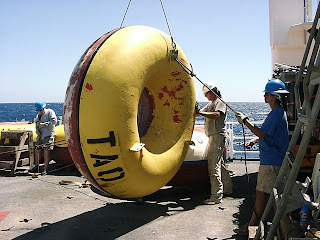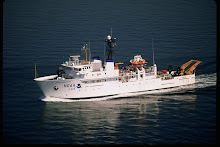 Today was a day of odds and ends. We had planned to paint first thing after breakfast and Art and Rick got started masking off the water line on one of the orange and white buoys that needs to be painted. This one was chosen to do first because it only needed a coat of yellow and not a complete repaint. The other three buoy floats need the rust colored anti-fouling paint
Today was a day of odds and ends. We had planned to paint first thing after breakfast and Art and Rick got started masking off the water line on one of the orange and white buoys that needs to be painted. This one was chosen to do first because it only needed a coat of yellow and not a complete repaint. The other three buoy floats need the rust colored anti-fouling paint and the yellow. Just about the time we got the tape on, it was determined that all the buoys
and the yellow. Just about the time we got the tape on, it was determined that all the buoyswould have the anti- fouling paint first so we had to wait while the tolroids or “donuts” were

flipped. In the process of turning them we discovered that a couple of the buoys were partially full of water and Alen had to drill them out to allow the water to pour out. While these were draining and drying we were put on hold for painting until tomorrow. Alen had to carefully look over the donuts and fix any cracks in the fiberglass hull and reseal the mounting brackets where they pass through the hull.
 Since painting was sidetracked for a day, we got to participate in one of the necessary, but less exciting aspects of scientific research…inventory. As we mentioned yesterday, science is hard work and hopping a buoy or working on the fantail doing fairings with the ocean breaking over the deck has an element of risk and can be exciting. In order to do the exciting parts of the
Since painting was sidetracked for a day, we got to participate in one of the necessary, but less exciting aspects of scientific research…inventory. As we mentioned yesterday, science is hard work and hopping a buoy or working on the fantail doing fairings with the ocean breaking over the deck has an element of risk and can be exciting. In order to do the exciting parts of theresearch safely and efficiently means that you have to have the right equipment and the right number of parts to make the instruments work and the science happen.
 So today we counted bolts, and paintbrushes, screwdrivers, nylon zip ties and even pencils and post-it notes, everything that allows us to do the science. Today was a reminder that even the most exciting job in the world, like climbing up a swaying mast on a ship, might have to be done because you need to get the serial number off an antenna, an antenna that allows you to communicate the fruit of your research back to those who can use it to understand the world’s climate a little better.
So today we counted bolts, and paintbrushes, screwdrivers, nylon zip ties and even pencils and post-it notes, everything that allows us to do the science. Today was a reminder that even the most exciting job in the world, like climbing up a swaying mast on a ship, might have to be done because you need to get the serial number off an antenna, an antenna that allows you to communicate the fruit of your research back to those who can use it to understand the world’s climate a little better.About 4:30 pm today we approached a TAO buoy that needed to be visually checked for any damage. Prior to this check, the ship makes several close passes to the buoy for examinination and more importantly so the crew can fish! Six long lines were in the water as we past the buoy on four separate occasions. No one caught any fish. However, Alen speculated that this was because the buoy had been deployed fairly recently and there was not enough time for it to form a food chain of small microorganisms that eventually attract top level carnivores like Ono, Tuna and Mahi Mahi. Bummer!
The last order of business today was to deploy the last deep (3000 meter) CTD at 8 South on the 155 West Longitude line. Rick sent the remainder of the Styrofoam cups from his school, cups for Art’s wife’s school in Helena (Rossiter Elementary) and a couple for his grand kids plus two extras he had for the Ensigns down in mesh bags attached to the instrument.
Soon we say farewell to the 155 West line as we make our way toward Apia, Samoa and the end of our experiences aboard the Ka'Imimoana.
Rick and Art



No comments:
Post a Comment